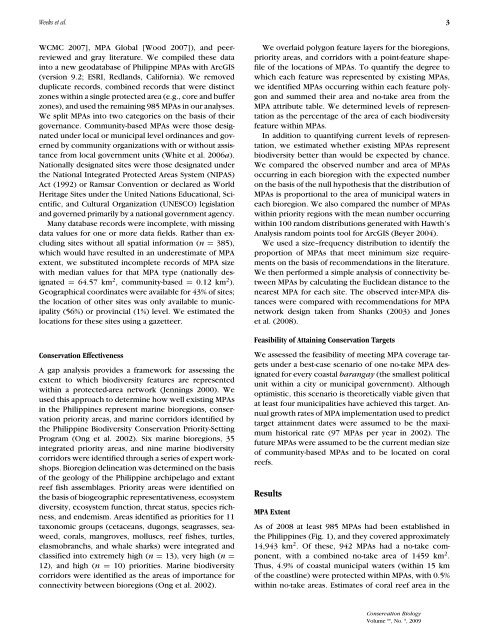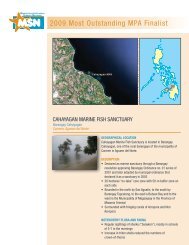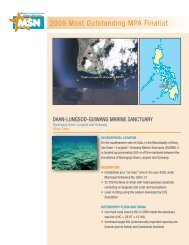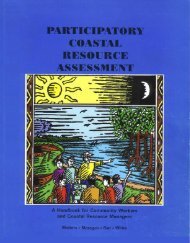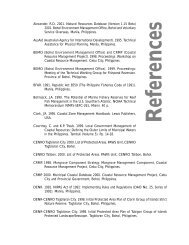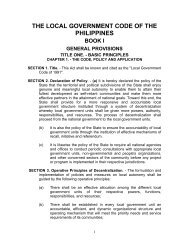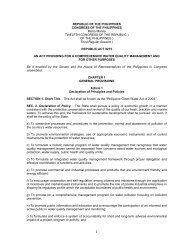Effectiveness of Marine Protected Areas in the Philippines for ...
Effectiveness of Marine Protected Areas in the Philippines for ...
Effectiveness of Marine Protected Areas in the Philippines for ...
Create successful ePaper yourself
Turn your PDF publications into a flip-book with our unique Google optimized e-Paper software.
Weeks et al. 3<br />
WCMC 2007], MPA Global [Wood 2007]), and peerreviewed<br />
and gray literature. We compiled <strong>the</strong>se data<br />
<strong>in</strong>to a new geodatabase <strong>of</strong> Philipp<strong>in</strong>e MPAs with ArcGIS<br />
(version 9.2; ESRI, Redlands, Cali<strong>for</strong>nia). We removed<br />
duplicate records, comb<strong>in</strong>ed records that were dist<strong>in</strong>ct<br />
zones with<strong>in</strong> a s<strong>in</strong>gle protected area (e.g., core and buffer<br />
zones), and used <strong>the</strong> rema<strong>in</strong><strong>in</strong>g 985 MPAs <strong>in</strong> our analyses.<br />
We split MPAs <strong>in</strong>to two categories on <strong>the</strong> basis <strong>of</strong> <strong>the</strong>ir<br />
governance. Community-based MPAs were those designated<br />
under local or municipal level ord<strong>in</strong>ances and governed<br />
by community organizations with or without assistance<br />
from local government units (White et al. 2006a).<br />
Nationally designated sites were those designated under<br />
<strong>the</strong> National Integrated <strong>Protected</strong> <strong>Areas</strong> System (NIPAS)<br />
Act (1992) or Ramsar Convention or declared as World<br />
Heritage Sites under <strong>the</strong> United Nations Educational, Scientific,<br />
and Cultural Organization (UNESCO) legislation<br />
and governed primarily by a national government agency.<br />
Many database records were <strong>in</strong>complete, with miss<strong>in</strong>g<br />
data values <strong>for</strong> one or more data fields. Ra<strong>the</strong>r than exclud<strong>in</strong>g<br />
sites without all spatial <strong>in</strong><strong>for</strong>mation (n = 385),<br />
which would have resulted <strong>in</strong> an underestimate <strong>of</strong> MPA<br />
extent, we substituted <strong>in</strong>complete records <strong>of</strong> MPA size<br />
with median values <strong>for</strong> that MPA type (nationally designated<br />
= 64.57 km 2 , community-based = 0.12 km 2 ).<br />
Geographical coord<strong>in</strong>ates were available <strong>for</strong> 43% <strong>of</strong> sites;<br />
<strong>the</strong> location <strong>of</strong> o<strong>the</strong>r sites was only available to municipality<br />
(56%) or prov<strong>in</strong>cial (1%) level. We estimated <strong>the</strong><br />
locations <strong>for</strong> <strong>the</strong>se sites us<strong>in</strong>g a gazetteer.<br />
Conservation <strong>Effectiveness</strong><br />
A gap analysis provides a framework <strong>for</strong> assess<strong>in</strong>g <strong>the</strong><br />
extent to which biodiversity features are represented<br />
with<strong>in</strong> a protected-area network (Jenn<strong>in</strong>gs 2000). We<br />
used this approach to determ<strong>in</strong>e how well exist<strong>in</strong>g MPAs<br />
<strong>in</strong> <strong>the</strong> Philipp<strong>in</strong>es represent mar<strong>in</strong>e bioregions, conservation<br />
priority areas, and mar<strong>in</strong>e corridors identified by<br />
<strong>the</strong> Philipp<strong>in</strong>e Biodiversity Conservation Priority-Sett<strong>in</strong>g<br />
Program (Ong et al. 2002). Six mar<strong>in</strong>e bioregions, 35<br />
<strong>in</strong>tegrated priority areas, and n<strong>in</strong>e mar<strong>in</strong>e biodiversity<br />
corridors were identified through a series <strong>of</strong> expert workshops.<br />
Bioregion del<strong>in</strong>eation was determ<strong>in</strong>ed on <strong>the</strong> basis<br />
<strong>of</strong> <strong>the</strong> geology <strong>of</strong> <strong>the</strong> Philipp<strong>in</strong>e archipelago and extant<br />
reef fish assemblages. Priority areas were identified on<br />
<strong>the</strong> basis <strong>of</strong> biogeographic representativeness, ecosystem<br />
diversity, ecosystem function, threat status, species richness,<br />
and endemism. <strong>Areas</strong> identified as priorities <strong>for</strong> 11<br />
taxonomic groups (cetaceans, dugongs, seagrasses, seaweed,<br />
corals, mangroves, molluscs, reef fishes, turtles,<br />
elasmobranchs, and whale sharks) were <strong>in</strong>tegrated and<br />
classified <strong>in</strong>to extremely high (n = 13), very high (n =<br />
12), and high (n = 10) priorities. <strong>Mar<strong>in</strong>e</strong> biodiversity<br />
corridors were identified as <strong>the</strong> areas <strong>of</strong> importance <strong>for</strong><br />
connectivity between bioregions (Ong et al. 2002).<br />
We overlaid polygon feature layers <strong>for</strong> <strong>the</strong> bioregions,<br />
priority areas, and corridors with a po<strong>in</strong>t-feature shapefile<br />
<strong>of</strong> <strong>the</strong> locations <strong>of</strong> MPAs. To quantify <strong>the</strong> degree to<br />
which each feature was represented by exist<strong>in</strong>g MPAs,<br />
we identified MPAs occurr<strong>in</strong>g with<strong>in</strong> each feature polygon<br />
and summed <strong>the</strong>ir area and no-take area from <strong>the</strong><br />
MPA attribute table. We determ<strong>in</strong>ed levels <strong>of</strong> representation<br />
as <strong>the</strong> percentage <strong>of</strong> <strong>the</strong> area <strong>of</strong> each biodiversity<br />
feature with<strong>in</strong> MPAs.<br />
In addition to quantify<strong>in</strong>g current levels <strong>of</strong> representation,<br />
we estimated whe<strong>the</strong>r exist<strong>in</strong>g MPAs represent<br />
biodiversity better than would be expected by chance.<br />
We compared <strong>the</strong> observed number and area <strong>of</strong> MPAs<br />
occurr<strong>in</strong>g <strong>in</strong> each bioregion with <strong>the</strong> expected number<br />
on <strong>the</strong> basis <strong>of</strong> <strong>the</strong> null hypo<strong>the</strong>sis that <strong>the</strong> distribution <strong>of</strong><br />
MPAs is proportional to <strong>the</strong> area <strong>of</strong> municipal waters <strong>in</strong><br />
each bioregion. We also compared <strong>the</strong> number <strong>of</strong> MPAs<br />
with<strong>in</strong> priority regions with <strong>the</strong> mean number occurr<strong>in</strong>g<br />
with<strong>in</strong> 100 random distributions generated with Hawth’s<br />
Analysis random po<strong>in</strong>ts tool <strong>for</strong> ArcGIS (Beyer 2004).<br />
We used a size–frequency distribution to identify <strong>the</strong><br />
proportion <strong>of</strong> MPAs that meet m<strong>in</strong>imum size requirements<br />
on <strong>the</strong> basis <strong>of</strong> recommendations <strong>in</strong> <strong>the</strong> literature.<br />
We <strong>the</strong>n per<strong>for</strong>med a simple analysis <strong>of</strong> connectivity between<br />
MPAs by calculat<strong>in</strong>g <strong>the</strong> Euclidean distance to <strong>the</strong><br />
nearest MPA <strong>for</strong> each site. The observed <strong>in</strong>ter-MPA distances<br />
were compared with recommendations <strong>for</strong> MPA<br />
network design taken from Shanks (2003) and Jones<br />
et al. (2008).<br />
Feasibility <strong>of</strong> Atta<strong>in</strong><strong>in</strong>g Conservation Targets<br />
We assessed <strong>the</strong> feasibility <strong>of</strong> meet<strong>in</strong>g MPA coverage targets<br />
under a best-case scenario <strong>of</strong> one no-take MPA designated<br />
<strong>for</strong> every coastal barangay (<strong>the</strong> smallest political<br />
unit with<strong>in</strong> a city or municipal government). Although<br />
optimistic, this scenario is <strong>the</strong>oretically viable given that<br />
at least four municipalities have achieved this target. Annual<br />
growth rates <strong>of</strong> MPA implementation used to predict<br />
target atta<strong>in</strong>ment dates were assumed to be <strong>the</strong> maximum<br />
historical rate (97 MPAs per year <strong>in</strong> 2002). The<br />
future MPAs were assumed to be <strong>the</strong> current median size<br />
<strong>of</strong> community-based MPAs and to be located on coral<br />
reefs.<br />
Results<br />
MPA Extent<br />
As <strong>of</strong> 2008 at least 985 MPAs had been established <strong>in</strong><br />
<strong>the</strong> Philipp<strong>in</strong>es (Fig. 1), and <strong>the</strong>y covered approximately<br />
14,943 km 2 . Of <strong>the</strong>se, 942 MPAs had a no-take component,<br />
with a comb<strong>in</strong>ed no-take area <strong>of</strong> 1459 km 2 .<br />
Thus, 4.9% <strong>of</strong> coastal municipal waters (with<strong>in</strong> 15 km<br />
<strong>of</strong> <strong>the</strong> coastl<strong>in</strong>e) were protected with<strong>in</strong> MPAs, with 0.5%<br />
with<strong>in</strong> no-take areas. Estimates <strong>of</strong> coral reef area <strong>in</strong> <strong>the</strong><br />
Conservation Biology<br />
Volume **, No. *, 2009


